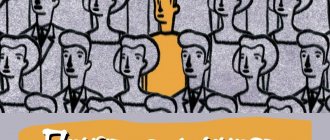Teenagers
Adolescence is a time of crises and discoveries that accompany the formation of personality. It is not for nothing that adolescence has become the most discussed period in psychological literature. The child finds himself in a new and completely uncertain situation: childhood is over, but the possibilities of adult life are not yet available. The crisis of adolescence is a bright but responsible time, one of the first turning points in life. And although teenagers strive for independence, they need the attention and support of their parents.
The psychology of a teenager has a fairly typical, but at the same time varied picture. Pubertal children think differently than adults: they have difficulty with self-control, are prone to taking unnecessary risks, and often misinterpret the attitudes of others. It would seem that just recently this was a sweet child, but now he has suddenly stopped making contact, constantly bickers, behaves withdrawn or even aggressively! Of course, such changes cause anxiety and irritation among parents.
To help a child safely go through the path of becoming his own “I,” the tactics of behavior with him must be very delicate. Thanks to modern advances in psychology and medicine, we have been able to “look” inside the teenage brain and see more clearly what the characteristics of the teenage psyche are. So what did we find?
Adolescence has rather blurred boundaries, but usually it is the age range from 12 to 17 years. Conventionally, younger adolescence is distinguished - 12-14 years old - and older - 15-17 years old. Neurobiological processes that occur during adolescence become a key behavioral factor.
One of the most interesting features of the teenage brain is the ability to change connections between different parts of the brain in response to events that happen in life. On the one hand, this contributes to a huge leap in the development of thinking and sensitivity. At the same time, constant change in structure leads to emotional instability and risky behavior.
Modern research tells us that problem behavior in adolescents arises from unbalanced functioning of different brain systems. We are talking mainly about two structures:
- The limbic system is responsible for emotions, sleep and memory. She becomes highly active during puberty.
- The prefrontal cortex is a part of the cerebral cortex that controls thinking, attention, and behavioral control. In adolescence, this structure is imperfect, does not function at full strength and reaches final maturity only by the age of twenty.
It turns out that young people experience a “gap” between emotions and common sense. Underdevelopment of the prefrontal region during adolescence explains the emergence of the main behavioral problems of difficult ages. This is not a sign of mental problems. Young people are not always able to correctly analyze a situation simply because important areas of their nervous system are not yet working as they should.
Teenage psychology of girls
It's not easy being a teenage girl, and it's not easy being her mom or dad. The modern generation of teenage girls is exposed to a huge number of traumatic factors that can lead to problems such as eating disorders, depression, alcohol abuse, problems in the formation of identity - the development of an integral personality.
Puberty is accompanied by changes throughout the body. The pituitary gland and thyroid gland begin to work intensively, which leads to significant changes in hormonal levels. As a result, changes occur in the physiological and emotional spheres.
Psychology views the teenage period in girls as a difficult but important stage of development, during which there is an acute need for recognition from peers and understanding from loved ones. The child faces new problems, but rarely asks adults for advice. This is hampered by maximalism and self-esteem: the girl believes that her parents do not understand her difficulties and any careless word risks causing severe resentment.
The psychology of teenage girls is designed in such a way that hormonal imbalance leads to frequent mood swings and the desire to stand out at any cost. There may be a depressive mood and emotional torment, which is why the girl moves away from her family and feels the need to join some subculture or other society of like-minded people.
When communicating with a teenage girl, you need to be patient. Under no circumstances should you yell or engage in provocative behavior.
Introduction
Every sixth person is in the 10–19 age group.
Adolescence is a unique, defining period of personality formation. Physical, emotional and social changes, including living in poverty, abuse and violence, can increase adolescents' vulnerability to mental health problems. Protecting adolescents from adversity, promoting social-emotional skills and psychological well-being, and ensuring access to mental health care are critical to their health and well-being during adolescence and adulthood. Mental disorders are estimated to affect one in seven adolescents aged 10–19 years worldwide (14%) (1); but these problems remain largely unrecognized and untreated.
Adolescents with mental health problems are particularly vulnerable to social isolation, discrimination, stigma (which limits their willingness to seek help), learning difficulties, risky behaviour, physical ill health and human rights violations.
Adolescent psychology of boys
One of the most common complaints expressed by parents of teenage boys is that their son has become angry and aggressive.
Teenage girls get angry too, but they are usually more receptive to constructive conversations, which gives parents a little more leverage. Psychology and medicine identify a surge in testosterone as a distinctive feature of adolescence in boys. Because of this, the feeling of fear is dulled and behavior is disinhibited. All this leads to frequent outbursts of anger and an abundance of conflicts.
The psychology of teenage boys is structured in such a way that in order to have a comfortable relationship with the outside world, they need to clearly understand responsibility for their behavior. The young man must understand that if he behaves responsibly, he will receive privileges, and vice versa. Teenagers are very receptive to rewards and encouragement.
Behavioral disorders
Behavioral disorders are more common in younger than in older adolescents. Attention deficit hyperactivity disorder (ADHD), characterized by difficulty concentrating, being overly active, and acting without considering consequences, affects 3.1% of adolescents 10–14 years of age and 2.4% of adolescents 15–19 years of age (1). Conduct disorder (which involves symptoms such as disruptive, challenging behavior) occurs in 3.6% of adolescents 10–14 years of age and 2.4% of adolescents 15–19 years of age (1). Behavioral disorders can negatively affect adolescents' learning, and conduct disorder can lead to illegal behavior.
When is the best time to see a psychologist with a teenager?
Sometimes it can be difficult to know whether your child's behavior is due to typical puberty experiences or whether it's time to seek professional help. Here is a list of “red flags” that indicate that a teenager, and possibly the whole family, needs the help of a specialist:
- depressed mood that lasts two weeks or more: this condition may indicate the presence of clinical depression. This includes signs such as melancholy, apathy, lack of interest in previous hobbies and any other things
- Signs of an eating disorder: weight loss or gain, regular refusal to eat or overeating followed by vomiting. In this case, it is necessary to exclude the presence of anorexia, bulimia and other dangerous syndromes
- sleep disorders and decreased vital energy: insomnia, pathological drowsiness and constant lethargy may be signs of diseases of the nervous system
- difficulties in managing emotions: isolation and withdrawal or, conversely, excessive irritability and conflict, which is often accompanied by the desire and threats to leave home. In order to smooth out the problem in time and prevent dangerous consequences in the form of accidents due to the risky behavior of a teenager, you need to consult a psychologist
- Regular use of alcohol, drugs and cigarettes – experimenting with chemicals is common during adolescence, but if your child regularly returns home under the influence of alcohol or other substances, you need to act immediately
- thoughts of death, self-harm or suicide attempts - in this case, you cannot assume that you can cope with the situation on your own. With suicide rates rising among teenagers, take the problem seriously and take your child to a therapist
These are the main signs, if present, you should contact a specialist. In other cases, you yourself can make sure that the period of growing up passes as smoothly and painlessly as possible. Here are some tips:
- Planned work and rest schedule: promotes better concentration and productive learning. In addition, looking tired can have a negative impact on your appearance, which is especially important for teenage girls.
- Interesting leisure time and hobbies: if a teenager has nothing to do after school, he will delve deeper into his internal problems. Exercising helps release pent-up energy and aggression.
- Help from specialists: do not be afraid to visit a pediatrician, therapist, psychologist or endocrinologist, especially if you see that the child’s mood and well-being is deteriorating
When raising a teenager, you should remember that this difficult period is not called transitional for nothing. Soon you will overcome the difficulties of growing up together, and your relationship will improve. Do not forget that the child loves you and needs your support, and his not always pleasant behavior is 90-100% due to insufficiently perfect structures of the nervous system and hormonal imbalance.
Lecture on the topic Mental development in adolescence
Topic 8. Mental development in adolescence
Lecture outline
1. Social situation of adolescent development.
2. Leading activities in adolescence 3. Features of mental development.
4. Personal development in adolescence
1 question. Social situation of adolescent development.
Adolescence is a period of completion of childhood, growing out of it, transition from childhood to adulthood. It usually correlates with chronological age from 10-11 to 14-15 years. The psychology of adolescence is presented in the works of domestic (L.S. Vygotsky, L.I. Bozhovich, D.B. Elkonin, etc.) and foreign (Z. Freud, E. Erikson, J. Piaget, A. Bandura, A. Vallon) scientists. In the modern period - in the works of V.S. Mukhina, L.F. Obukhova, K.N. Polivanova, V.I. Slobodchikov, D.I. Feldshtein and others. The psychology of a teenager is also presented in fiction.
Assignment for students
: What books about a teenager can you name? Determine what characteristics of a teenager were highlighted by the great Russian writer?
“It’s strange why, when I was a child, I tried to be like a big man, and since I stopped being one, I often wanted to be like him. How many times did this desire - not to be like a little one, in my relationship with Seryozha, stop the feeling that was ready to pour out, and force me to be a hypocrite. Not only did I not dare to kiss him, which I sometimes really wanted to do, to take his hand, to say how glad I was to see him, but I did not even dare to call him Seryozha, and certainly Sergei: that was the custom with us. Every expression of sensitivity proved childishness and the fact that the one who allowed himself to be still a boy. Having not yet gone through those bitter trials that lead adults to caution and coldness in relationships, we deprived ourselves of the pure pleasures of tender childish affection just by the strange desire to imitate the big ones” (Tolstoy L.N. Childhood // Selected Works. M., 1985 . P. 110).
The most important source of a teenager’s development is the environment and his activity in the environment; the driving force of mental development is learning focused on the zone of proximal development (according to L.S. Vygotsky). The teenager continues to be a schoolboy; educational activity remains relevant, but psychologically recedes into the background.
The main contradiction of adolescence is the child’s persistent desire for recognition of his personality by adults in the absence of a real opportunity to establish himself among them. Peculiarities of age are manifested in the fact that activity and the ability to reflect begin to be “directed” by the teenager towards himself. Comparing himself with others leads a teenager to the conclusion that he is no longer a child. The teenager begins to feel like an adult and wants others to recognize his independence and importance. Associated with this are other needs of the teenager - the desire to communicate with peers (“grouping”), to independence and independence, “emancipation” from adults, to recognition of their rights by other people.
Feelings of adulthood are a psychological symptom of the onset of adolescence. According to the definition of D.B. Elkonin, “the feeling of adulthood is a new formation of consciousness, through which a teenager compares himself with others (adults or friends), finds models for assimilation, builds his relationships with other people, rebuilds his activities” (Elkonin D.B. Selected psychological works. M. ,2015.С220).
The transition of adolescence, of course, includes a biological aspect. This is the period of puberty, the intensity of which is emphasized by the concept of “hormonal storm”. Physical, physiological, psychological changes, the emergence of sexual desire make this period extremely difficult, including for the most rapidly growing teenager in every sense. However, the works of anthropologists (M. Mead, R. Benedict, etc.) show that in the so-called primitive cultures, the teenage crisis and associated conflicts are absent. In these cultures there is no polarization of the behavior and responsibilities of an adult and a child, but there is an interconnection; There is a gradual learning and transition to adult status through a special initiation procedure. These data refute the hypothesis about the biological conditionality, genetic programming of the crisis, about its direct connection with the process of puberty. In this case, the so-called social factors come to the fore.
Assignment for students:
Do you think there is a relationship between the boundaries, content of adolescence and the social situation of adolescent development? Express your opinion based on J. London’s story “The Renegade”
“Johnny became an adult very early. At the age of seven, when he received his first salary, his adolescence began. He developed a certain sense of independence, and the relationship between mother and son changed. He earned his bread, lived by his labor, and thus seemed to be on an equal footing with her. He became an adult, a real adult, at the age of eleven, after working on the night shift for six months. No child working the night shift can remain a child." At twelve years old, “he was very old, and they (brothers and sisters - I.Sh.) were insultingly young. This excessive and incomprehensible youth irritated him. He didn't understand her. His own childhood was too far behind him. Like a grumpy old man, Johnny was disgusted by this violent mischief, which seemed to him blatant stupidity” (London J. Apostate // Works: In 7 vols. M., 1954. T. 2. pp. 149-150).
Until the 17th-18th centuries, adolescence was not distinguished as a special age period; it was a relatively recent historical formation. In the 19th century Systematic schooling was introduced in many countries. This led to an increase in the period of economic dependence in the child's life and to a delay in the moment of acceptance of the roles characteristic of an adult. The boundaries and content of adolescence are closely related to the level of socio-economic development of society, to the characteristics of historical times, to the social position of adolescents in the adult world and to the specific circumstances of the life of a given teenager. Adolescence as a “transitional” age fully unfolds in an industrial society, where a pronounced gap arises in the norms and requirements for generations of adults and children. In modern society, social adulthood does not coincide with the moment of puberty.
The first to single out adolescence as the time of the second, independent birth and growth of a person’s self-awareness was Zh.Zh. Rousseau. The main ideas that still form the core of the psychology of adolescence today were outlined in S. Hall’s work “Growing Up.” Hall formulated the idea of transition, the in-betweenness of adolescence, the period of “storm and stress.” He developed the content-negative characteristics of this stage of development (difficulty in education, conflict, emotional instability) and outlined the positive acquisition of age - “a sense of individuality.”
K. Levin spoke about the peculiar marginality of a teenager, expressed in his position between two cultures - the world of children and the world of adults. The teenager no longer wants to belong to children’s culture, but still cannot enter the community of adults, encountering resistance from reality, and this causes a state of “cognitive imbalance”, uncertainty of guidelines, plans and goals during the period of change of “living spaces”.
The development of a teenager's personality was analyzed in a psychoanalytic manner by 3. Freud and A. Freud. During adolescence, puberty, a surge of sexual energy, shakes the previously established balance between personality structures, and childhood conflicts are revived with renewed vigor (Freud Z. Introduction to psychoanalysis. M., 2014. pp. 145-157). E. Erikson considered adolescence and adolescence as the central period for solving the problem of personal self-determination, achieving identity (Erikson E. Childhood and Society. St. Petersburg, 2015. pp. 127-153).
In Russian psychology, patterns of adolescent development are presented in the works of L.S. Vygotsky, D.B. Elkonina, T.V. Dragunova, L.I. Bozhovich, D.I. Feldshteina, G.A. Tsukerman et al. Often the entire adolescence period is interpreted as a crisis, as a period of “normal pathology,” emphasizing its rapid course, complexity both for the teenager himself and for the adults communicating with him (for example, Bozhovich L.I. Problems of personality formation. M., 2013. pp. 141-157).
L. S. Vygotsky in his work “Pedology of the Adolescent” distinguishes 2 phases of adolescence: negative and positive, the phase of drives and the phase of interests. D.B. Elkonin considers adolescence as a stable age and identifies crises (pre-adolescent and during the transition to adolescence) (Elkonin D.B. Selected psychological works. M., 2015. P122-143). Adolescence as a stage of mental development is characterized by the child’s emergence into a qualitatively new social position associated with the search for his own place in society.
Symptoms of the crisis are: loss of spontaneity of behavior, a sense of adulthood, decreased motivation to study, “internal withdrawal from school,” conflicts with teachers, protest behavior in the family. This is an external picture of the internal, deep changes that occur with a child during the transition to adolescence. The main psychological content of the crisis is a reflexive “turn on oneself”, a reflexive attitude towards the desired adulthood.
Intimate and personal communication with peers becomes the leading activity in adolescence (according to D.B. Elkonin). At the beginning of adolescence, the activities of communication, conscious experimentation with one’s own relationships with other people (searching for friends, sorting out relationships, conflicts and reconciliations, changing companies) become a relatively independent area of life. The main need of the period - to find one’s place in society, to be “significant” - is realized in a community of peers. For adolescents, the opportunity to widely communicate with peers determines the attractiveness of activities and interests. If a teenager cannot take a satisfactory place in the communication system in the classroom, he “leaves” school both psychologically and even literally.
The dynamics of motives for communicating with peers throughout adolescence are traced: the desire to be among peers, to do something together (10-11 years); motive to take a certain place in a group of peers (12-13 years old); the desire for autonomy and the search for recognition of the value of one’s own personality (14-15 years old). In communication with peers, various aspects of human relationships are played out, relationships are built based on the “code of camaraderie,” and the desire for deep mutual understanding is realized.
Intimate and personal communication with peers is an activity in which the practical development of moral norms and values occurs. Self-awareness is formed in it as the main new formation of the psyche. Even the basis for deterioration in academic performance may be impaired communication with peers. At primary school age, solving the problem of academic performance often leads to harmonization of communication with peers, to increased self-esteem, etc. In adolescence, on the contrary, relieving tension in communication and easing personal problems can lead to improved academic performance.
Another point of view regarding the nature of the leading activity of adolescence belongs to D.I. Feldstein. He believes that the main importance in the mental development of adolescents is socially useful, socially recognized and approved activities. Prosocial activity can be presented as educational and cognitive, industrial and labor, organizational and social, artistic or sports, but the main thing is the teenager’s feeling of the real significance of this activity. The content of the activity is something useful for people, for society; the structure is determined by the goals of adolescent relationships. The motive for socially useful activities of a teenager is to be personally responsible and independent. Socially useful activities are also available in primary schools, but they are not sufficiently developed.
Attitudes towards socially useful activities change at different stages of adolescence [4, pp. 357-359]. Between 9 and 10 years, the child develops a desire for self-affirmation and recognition in the adult world. The main thing for 10-11 year olds is to get other people to evaluate their capabilities. Hence their focus on activities similar to those performed by adults, the search for activities that have real benefits and receive public appreciation. The accumulation of experience in various types of socially useful activities activates the need of 12-13 year olds for recognition of their rights, for inclusion in society under the conditions of fulfilling a certain, significant role. At the age of 14-15, a teenager strives to demonstrate his capabilities and take a certain social position, which meets his need for self-determination. Socially significant activity as the leading type of activity in adolescence must be purposefully formed. A special organization, a special structure of socially useful activity requires reaching a new level of motivation, the implementation of a teenager’s orientation towards the “I and society” system, the deployment of diverse forms of communication, including the highest form of communication with adults on the basis of moral cooperation.
According to D.I. Feldshtein, the intimate-personal and spontaneous-group nature of communication prevails if there are no opportunities for carrying out socially significant and socially approved activities, and the opportunities for pedagogical organization of socially useful activities of adolescents are missed.
The teenager’s desire to occupy a position that satisfies him in a peer group is accompanied by increased conformity to the norms of behavior and values of the reference group, which is especially dangerous if he joins an antisocial community. The transition of the adolescent psyche consists in the coexistence and simultaneous presence in it of the features of childhood and adulthood. In adolescence, a tendency to behavioral reactions that are usually characteristic of younger people often remains. These include the following:
1. Refusal reaction. It is expressed in the refusal of usual forms of behavior: contacts, household duties, study, etc. The reason most often is a sharp change in usual living conditions (separation from family, change of school), and the soil that facilitates the occurrence of such reactions is mental immaturity, neurotic traits.
2. Reaction of opposition, protest. It manifests itself in the opposition of one’s behavior to the required one: in demonstrative bravado, in absenteeism, escapes, thefts, and even actions that seem ridiculous at first glance, performed as protests.
3. Imitation reaction. It is usually characteristic of childhood and manifests itself in imitation of relatives and friends. For teenagers, the object of imitation most often becomes an adult who has certain qualities that appeal to his ideals (for example, a teenager who dreams of theater imitates his favorite actor in manners). The imitation reaction is characteristic of personally immature adolescents in an antisocial environment.
4. Compensation reaction. It is expressed in the desire to make up for one's failure in one area with success in another. If antisocial manifestations are chosen as a compensatory reaction, then behavioral disorders arise. Thus, an underachieving teenager may try to gain authority from his classmates with rude, defiant antics.
5. Overcompensation reaction. It is determined by the desire to achieve success precisely in the area in which the child or adolescent shows the greatest inconsistency (in case of physical weakness - a persistent desire for sports achievements, in case of shyness and vulnerability - for social activities, etc.).
Adolescent psychological reactions themselves arise during interaction with the environment and often form characteristic behavior during this period:
1. Reaction of emancipation. It reflects the teenager’s desire for independence, for liberation from adult care. Under unfavorable environmental conditions, this reaction may underlie runaways from home or school, affective outbursts directed at parents, teachers, as well as individual antisocial behavior. 2. “Negative imitation” reaction. It manifests itself in behavior that contrasts with the unfavorable behavior of family members, and reflects the formation of an emancipation reaction, the struggle for independence.
3. Grouping reaction. It explains the desire to form spontaneous teenage groups with a certain style of behavior and a system of intra-group relationships with their leader. In unfavorable environmental conditions, with various types of inferiority of the adolescent’s nervous system, the tendency to this reaction can largely determine his behavior and be the cause of antisocial actions.
4. Infatuation reaction (hobby reaction). It reflects the characteristics of the internal structure of a teenager’s personality. Passion for sports, desire for leadership, gambling, and a passion for collecting are more typical for teenage boys. Activities that are motivated by the desire to attract attention (participation in amateur performances, a passion for extravagant clothing, etc.) are more typical for girls. Intellectual and aesthetic hobbies, reflecting a deep interest in a particular subject or phenomenon (literature, music, fine arts, technology, nature, etc.), can be observed in adolescents of both sexes [3, pp. 80-82].
It is generally believed that during adolescence, distancing and alienation from adults occurs. Indeed, the desire to oppose oneself to an adult, to sharply highlight one’s own special position and one’s rights as an independent subject, manifests itself very clearly. But modern data suggests that the relationship between a teenager and an adult is complex and ambivalent. The teenager simultaneously insists on recognizing the fundamental equality of rights with an adult, and still needs his help, protection and support, and his assessment. An adult is important and significant for a teenager; a teenager is capable of empathy towards an adult, but protests against the preservation in the practice of education of “childish” forms of control, demands for obedience, and expressed guardianship.
Although problems in relationships with parents and conflicts with teachers are a typical phenomenon for adolescence, the strength, frequency, and severity of manifestations largely depend on the position of adults, on the style of family education, on the ability to implement respectful, but not condoning tactics in relation to the behavior of a teenager. A necessary and mandatory condition for a successful relationship between a teenager and an adult is the creation of community in their lives, meaningful contacts, expansion of the sphere of cooperation, mutual assistance and trust, best of all on the initiative of an adult [2, p.91-
93].
Assignment for students
: Based on an analysis of scientific literature on psychology, prepare electronic presentations on the topic of leading activities in adolescence.
Cognitive development in adolescence.
Early adolescence is characterized by an increase in cognitive activity (“the peak of curiosity” occurs at 11–12 years old) and an expansion of cognitive interests. In adolescence, the intellectual processes of a teenager are actively improved. In Western psychology, the development of intelligence in adolescence is considered from the point of view of improving its structure: there is a transition to formal logical operations (J. Piaget). In Russian psychology, within the framework of the system-functional approach, it is believed that in adolescence the central, or leading, function is the development of thinking, the function of concept formation [1.p.137-141]. Under the influence of learning, the assimilation of more generalized knowledge and the fundamentals of science, higher mental functions are gradually transformed into well-organized, voluntarily controlled processes. Changes in the cognitive sphere affect the attitude of adolescents to the surrounding reality, as well as the development of personality as a whole. Perception becomes a selective, purposeful, analytical-synthetic activity. All basic parameters of attention are qualitatively improved: volume, stability, intensity, ability to distribute and switch; it turns out to be a controlled, voluntary process. Memory is internally mediated by logical operations; memorization and reproduction acquire a semantic character. The volume of memory, selectivity and accuracy of mnemonic activity increases. The processes of thinking are gradually restructured - operating with specific ideas is replaced by theoretical thinking. Theoretical discursive (reasoning) thinking is built on the ability to operate with concepts, compare them, and move from one judgment to another in the course of reflection. In connection with the development of independent thinking and the transition to proactive cognitive activity, individual differences in intellectual activity intensify.
The ideal model presented above of the level of mental and personal development that every teenager should achieve under favorable conditions (training and upbringing) is not always realized. A comprehensive study conducted in middle and high schools showed that the achievements of many schoolchildren are very far from theoretically possible. Of decisive importance for the development of theoretical thinking and logical memory is the organization and motivation of educational activities in the middle grades of school, the content of educational programs, the system of methods for presenting educational material and monitoring its assimilation.
Question 4. Personal development in adolescence
Personal instability is one of the main characteristics of a teenager. The key to the whole problem of a teenager, according to L.S. Vygotsky, is a problem of interests (Vygotsky L.S. Psychology of child development. M., 2013. P. 37-45). He identifies the following groups of interests of a teenager: - interest in one’s own personality,
- the desire for the unknown, the risky, for heroism, adventure, - the desire to overcome, for volitional tension, resistance - an attitude towards distance, on a large scale.
An essential feature of a teenager is the need for a “meeting” with his own self, an interest in the inner world. The main new development of this period is the internalization of social consciousness, the formation of self-awareness. The emerging self-concept of a teenager is initially unstable and inconsistent. Self-attitude can range from narcissism to self-loathing, from absolute acceptance to rejection. During adolescence, overall self-esteem decreases somewhat and negative self-perception increases. Self-esteem of adolescents is influenced by relationships with peers and the degree of acceptance of their body image.
Moral self-regulation and the ability to monitor one’s behavior continue to improve. According to J. Piaget, a transition to autonomous morality is taking place. L. Kohlberg argues that adolescents are at the conventional level in moral development. By the end of adolescence, the formation of will associated with life plans occurs. The emergence of self-regulation, ways of mastering one’s own behavior is a criterion for the transition from adolescence to adolescence and an essential parameter of psychological health and psychological maturity at this stage of age development.
Conclusion:
The main new development of adolescence is the emergence
of a sense of adulthood.
It is expressed in the desire to assert adulthood in real behavior or at least appear to be an adult.
The formation of a system of interests, the discovery of the inner world, personal reflection, abstract logical thinking, verbal and logical memory, lengthening of time perspective, a tendency to introspection and the desire for self-affirmation - all these are new formations of adolescence. As a result, by the end of adolescence, the formation of Self-Concept
as an integrative system of ideas about oneself occurs. It is associated with assessment and attitude towards oneself and is the central new formation of the entire adolescence period.
Early detection and treatment
Responding to the needs of adolescents with mental health problems is essential. The main principles of work in the field of mental health of adolescents are to avoid referral and over-medication, primarily use non-pharmacological methods and respect children's rights in accordance with the United Nations Convention on the Rights of the Child and other documents on human rights.
Personality and behavior
- Moral qualities of the student.
- Attitude to work and study: positive, indifferent, negative. Interest, hard work, attitude towards teachers and educators.
- Discipline, attitude to rules and requirements, behavior in lessons, when preparing homework, during events, in a group, in free time, in public places. Level of formation of social norms. Motives for discipline or violation of discipline. Having a sense of duty and responsibility.
- Manifestation of strong-willed qualities. The presence of strong-willed character traits, purposefulness of actions and deeds, determination, the ability to overcome difficulties and demonstrate strong-willed effort. Disadvantages in the development of the will: easy suggestibility, control, pliability, self-will, impulsiveness, absent-mindedness, avoidance of difficulties, etc. The level of formation of motives and needs, the presence of defects in legal consciousness and value-normative orientations. The relationship between the incentive and meaning-forming functions of motives, the level of mediation of motives.
- Cultural behavior skills: politeness, attentiveness, sensitivity, responsiveness, neatness. The degree of stability of these skills.
- Interests in extracurricular activities, work assignments, club work, sports, games and other leisure activities. Diversity of interests, stability, selectivity, focus, awareness, forms of expression of interests. Assessment of student interests by teacher and educator. The means used by the teacher to maintain the interests and their development in a given child.
- Character traits. The presence of moral character traits: kindness, sincerity, hard work, restraint, modesty, honesty, self-criticism, self-confidence, collectivism. The presence of difficult character traits: selfishness, isolation, secrecy, negativism, inflated claims, laziness, deceit, capriciousness, hot temper, aggressiveness, pugnacity, etc.
- The nature of emotions and higher feelings: stability of moods, tendency to affective outbursts, duration and inadequacy of experiences, reactions to success and failure. Level of development of higher feelings: camaraderie, honesty, duty, honor, patriotism, collectivism, etc. Level of self-esteem, presence of self-criticism, assessment of others, forecasting one’s own future.
- Place in the team, role in the team (leader, outsider), respect from comrades and his comrades. Isolation, partial or complete, its causes. Stable relationships with friends. Having your own opinion, the ability to take public opinion into account and obey it. Having close friends.
- Belief system, interest in social events in our country. The desire to be useful to the team and society.
- Presence of bad habits, registration with law enforcement agencies, social services, and prevention system agencies. Level of orientation in the surrounding world, level of independence of actions. Availability of sanitary and hygienic skills, level of their development and ability to apply them in practice.
Scheme of psychological and pedagogical characteristics of the classroom team
The history of its formation (number of students, including boys and girls, age composition, when the team was formed, whether there were mergers with other teams, changes in class teachers).
a) the organizing core of the class, its asset. Team independence and perseverance, demands on oneself and others, organizational skills, concern for individual comrades, attitude towards public opinion;
b) the presence of unofficial “leaders” in the team, the nature of their influence on the class, the reasons for their influence, the attitude of the class activist towards the “leaders”; the presence of “outcasts”, reasons for rejection and possible ways to change the attitude of their comrades towards them; relationships within the team (the degree of cohesion of the team, the presence or absence of groupings, their internal basis and the degree of interest in the common affairs of the class, the manifestation of mutual demands, sensitivity, friendly care, mutual assistance and respect); criticism and self-criticism in a team, features of relationships between boys and girls; manifestation of camaraderie and friendship between individual members of the team, emotional “well-being” and “distress” of individual members of the team;
c) the personality of the class teacher and his influence on the team (education, general culture, organizational skills, knowledge of the psychology of students, their interests, etc.); the attitude of the team towards the class teacher, his authority among students.
a) educational activities (general characteristics of academic performance and discipline, the struggle of the class for high academic performance, the presence of control over the progress of individual students, the requirements for them of the class teacher, the activists of the class and the entire team, mutual assistance, its form and organization); class discipline in educational activities (in lessons and in doing homework); negative aspects in academic work (cheat sheet, hint, cheating);
b) the life of the team outside of classes; interest in modern political events, music, literature and sports, collecting, etc.; forms of manifestation of this interest (reader conferences, visits to theaters, cinema, their discussion, debates, etc.); participation of the class team in public life;
c) socially useful work and its place in the extracurricular life of the team; types of work and the nature of its performance; manifestation of conscious discipline in socially useful work.
Level (stage) of team development. The nature of the general “emotional climate” in the team (cheerful, cheerful, inert, tense-nervous, etc.). The nature of discipline. Determination of the main shortcomings in the organization of the life of a team and the relationship of its members, ways to eliminate them.
When considering it, the class staff should be considered, first of all, from the point of view of educational capabilities. And this largely depends on the nature and content of collective life and activity. It is important to identify the attitude of the class team towards learning: how conscientiously they treat their educational responsibilities, whether they are interested in academic disciplines and which ones. A deep interest in learning is revealed not only in class performance, but also in club work and Olympiads.
It is important to pay attention to how educational activities unite the children, whether there is mutual assistance in the class, whether the children experience the successes and failures of their comrades, and whether they fight for high performance. The character of the team’s life also manifests itself outside of class. The trainee determines whether the student willingly participates in social work, in interesting and useful activities of the school, whether labor cooperation and mutual assistance arise, forming a sense of collectivism.
Analyzing the content and forms of collective activity of the class, it is necessary to especially note how it is connected with the life of the entire school community, with the entire society.
And finally, you should pay attention to the existing interpersonal relationships, since their system largely determines the impact of the team on the individual, his well-being, and creates the general emotional climate in the class.
The relationship between students in a team develops in two directions: business relationships and personal ones. Business relations are determined by the social function of each member of the team, in connection with which one can demand, the other must obey and fulfill. But at the same time, children are not indifferent to each other as individuals. Some are sympathetic, others are indifferent; They are drawn to someone, want to be friends, while others are internally rejected. These informal internal relationships have a strong impact on the life of each student and on the activities of the team as a whole.
It is known that for each student in a class group, as a rule, there is his own microsphere, his own circle of closest contacts, his own micro-team, in which he is accepted and takes his place, plays his role. This group is called the reference group. This is where special relationships are formed. Its own ethics, its own unwritten laws. And if group ethics and the content of small groups contradict the requirements of the classroom (school) team, then this often reduces its educational capabilities to zero.
The official structure of the class team does not always correspond to real interpersonal relationships. Activists are not always the most authoritative. Often, class leaders are schoolchildren who do not hold any “positions,” including those who negatively influence other children. It is not difficult to imagine how important it is for a teacher to know the interpersonal relationships of children, class leaders and “outcasts” in order to effectively manage the team and actively influence the formation of each individual.
From the general psychology course, students know sociometric methods for studying interpersonal relationships in a team. During the period of teaching practice, they become the topic of independent research, without which teaching work is unthinkable.
Suicide and self-harm
Suicide is the fourth leading cause of death in late adolescence (15–19 years) (2). Risk factors for suicide are varied and include harmful alcohol use, childhood abuse, help-seeking stigma, barriers to help, and access to means of suicide. Digital media, like any other media, can play a significant role in enhancing or weakening suicide prevention efforts.










